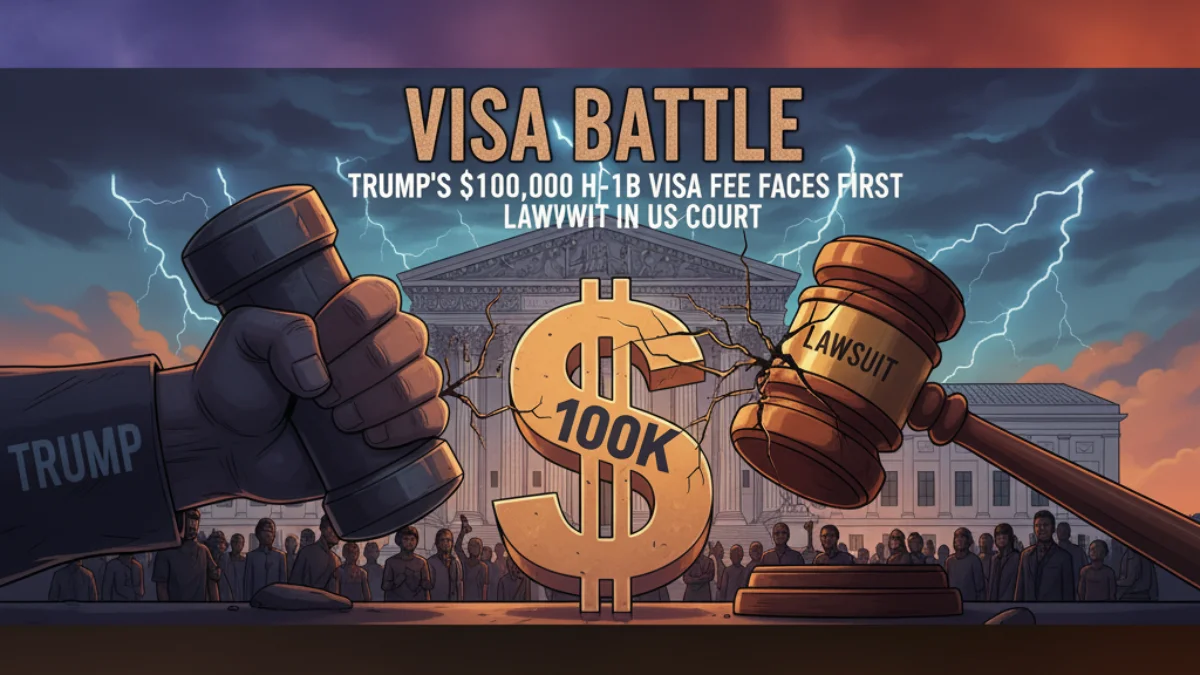Introduction:
President Donald Trump's proclamation imposing a $100,000 one-time fee on new H-1B visa applications has encountered its first legal hurdle, with a diverse coalition of labor unions, employers, academic groups, and religious organizations filing a lawsuit in federal court in San Francisco on October 3, 2025.
The H-1B program, established in 1990, allows US companies to hire skilled workers in specialty occupations for up to six years, with employers currently paying modest fees of $2,000-$5,000.
Details of the Lawsuit: Plaintiffs and Filing
The lawsuit was filed in the US District Court for the Northern District of California, the first major legal action against Trump's H-1B fee proclamation issued on September 20, 2025.
The complaint accuses the administration of exceeding presidential authority under the Immigration and Nationality Act, which allows restrictions on entry but not revenue-generating fees—a power reserved for Congress.
Arguments Against the Fee: Legal and Practical Challenges
Plaintiffs contend:
- Unconstitutional Overreach: Trump cannot impose taxes or fees unilaterally; only Congress holds that power.
- Arbitrary and Capricious: The $100,000 fee lacks rational basis, opening exemptions to corruption via Homeland Security discretion.
- Harm to Stakeholders: Schools, hospitals, churches, and small businesses reliant on H-1B for doctors, engineers, and teachers face shortages.
- National Security Pretext: The fee doesn't enhance security but disrupts innovation, as tech firms argue.
The suit requests vacating the proclamation and fee.
Trump's Justification and White House Defense
The White House defends the fee as fulfilling Trump's pledge to prioritize American workers, claiming H-1B has been abused to undercut wages.
Impacts on Businesses and Workers: Tech Sector Chaos
- Tech Giants: Amazon, Apple, Google, Microsoft—reliant on H-1B for 70% of skilled hires—face hiring freezes abroad.
- Workers: Current H-1B holders exempt, but new applicants must pay or seek waivers; chaos ensued with deplaning requests and canceled trips.
- Economy: Potential $100B+ GDP hit if prolonged, per immigration economists, stifling innovation.
Nurse agencies and universities cite immediate harm.
Historical Context: H-1B and Previous Legal Battles
- H-1B Origins: 1990 law for specialty occupations; cap 85,000 annually.
- Trump 1.0: 2017-2021 restrictions via "Buy American, Hire American" executive order, challenged in courts (e.g., 2020 lottery rule struck down).
- Biden Era: Expanded access; Trump 2.0 reverses with fee.
Similar suits succeeded, like 2018 travel ban blocks.

Expert Opinions: Legal and Economic Views
- Preet Bharara (Former US Attorney): "Strong case; executive can't create taxes—Congress's domain."
- Kate Rooney (CNBC): "Chaos for tech; fee could kill H-1B's purpose."
- Immigration Lawyer Greg Siskind: "Likely injunction; violates INA explicitly."
Consensus: Winnable challenge; disrupts talent flow.
Potential Outcomes: Court Rulings and Policy Shifts
- Injunction Likely: Courts may block fee pending review, as in 2017 travel ban cases.
- Supreme Court Appeal: Possible escalation, delaying implementation.
- Policy Reversal: If struck down, reverts to $2,000-$5,000 fees.
- Broader Effects: Could limit Trump's immigration agenda.
Timeline: Hearing in weeks; decision by November 2025.
Conclusion: A Legal Battle for H-1B's Future
The October 3, 2025, lawsuit against Trump's $100,000 H-1B fee challenges executive overreach, potentially restoring the program's accessibility amid chaos for workers and employers. As courts deliberate, the stakes for tech and immigration remain high. Track developments on Reuters or nuvexic.com.
You may also find these related articles useful US Embassy Shutdown: Impacts on Visa Services and Operations Amid 2025 Government Lapse and Putin Orders Moscow to Ease Russia-India Trade Imbalance, Praises Modi
FAQ
Q1-What is the lawsuit against Trump's H-1B visa fee?
The lawsuit, filed on October 3, 2025, in San Francisco federal court by unions, employers, and religious groups, challenges the $100,000 fee as unlawful overreach, arguing President Trump lacks authority to impose revenue-generating requirements on the H-1B program, which Congress created, and that it invites corruption through discretionary exemptions by Homeland Security.
Q2-Who are the plaintiffs in the H-1B fee case?
Plaintiffs include the United Auto Workers union, American Association of University Professors, a nurse recruitment agency, religious organizations, and individual visa holders, all harmed by the fee's chaos, such as workers deplaning in panic or canceling trips, and businesses facing hiring disruptions in sectors like healthcare and tech that rely on H-1B for skilled foreign talent.
Q3-Why does the lawsuit claim the fee is illegal?
The suit asserts the fee violates the Immigration and Nationality Act, as only Congress can set taxes or fees, not the president, and deems it "arbitrary and capricious" for transforming H-1B into a "pay to play" system open to selective enforcement and corruption, without rational basis for protecting wages or security as claimed by the administration.
Q4-What immediate effects has the $100,000 fee caused?
The fee has sown confusion, with H-1B workers abroad rushing back to the US, spending thousands on flights or deplaning in panic upon hearing the news, while employers face immediate hiring barriers, disrupting schools, hospitals, and small businesses dependent on the program for doctors, engineers, and researchers.
Q5-How might the lawsuit impact the H-1B program?
A successful lawsuit could vacate the fee, restoring the original $2,000-$5,000 costs and reaffirming congressional authority over visa programs, potentially setting precedents limiting executive immigration powers, while failure might reshape H-1B into an elite tool favoring large corporations able to pay, stifling innovation and access for smaller entities.

